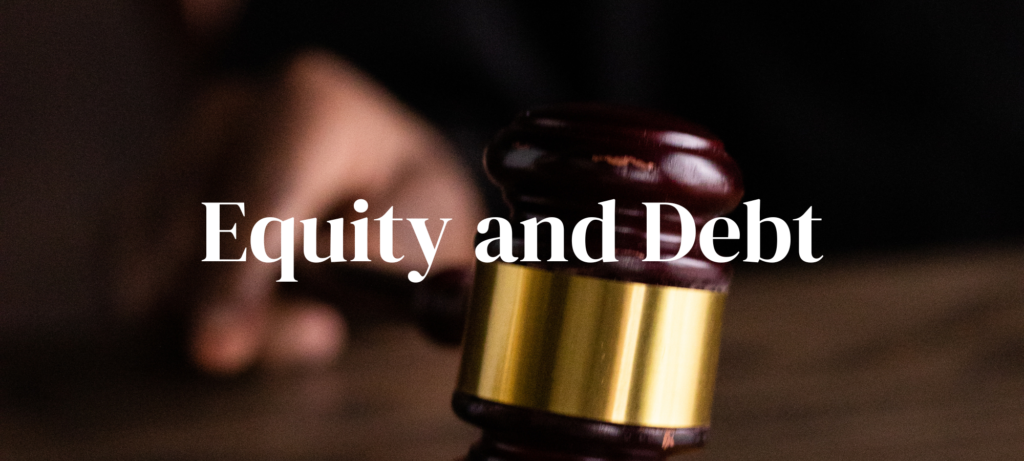
Understanding Equity and Debt: Key to Financial Management
In the world of finance and investment, understanding the dynamics of Equity and Debt is essential for businesses, investors, and financial analysts. The balance between these two sources of finance plays a critical role in determining a company’s financial health, profitability, and risk profile. One of the most vital tools used to evaluate this balance is the debt-to-equity ratio.
What is Equity and Debt?
Equity and Debt are two fundamental ways a company can raise capital to fund its operations and growth.
Debt refers to borrowed funds that must be repaid over time with interest. This can include bank loans, bonds, and other financial obligations.
Equity represents ownership in a company, typically in the form of shares. Shareholders are entitled to a portion of the company’s profits and assets.
The right mix of Equity and Debt in a company’s capital structure is crucial in determining its long-term viability, cost of capital, and ability to sustain growth.
Equity and Debt Ratio Meaning
The Equity and Debt ratio meaning lies in its ability to reflect a company’s financial leverage. It is a measure of the proportion of debt a company uses to finance its assets relative to shareholders’ equity.
A higher Equity and Debt ratio implies that a company relies more on borrowed money, which can be risky during economic downturns. Conversely, a lower ratio indicates a more conservative approach with a heavier reliance on equity financing.
Equity and Debt Ratio Equation
The standard Equity and Debt ratio equation is:
Equity and Debt Ratio = Total Liabilities / Shareholders’ Equity
This simple formula forms the basis of analyzing a firm’s capital structure. When applied correctly, the debt to equity ratio equation helps identify the financial risk a business may face in servicing its obligations.
Equity and Debt Ratio Interpretation
Proper Equity and Debt ratio interpretation is essential. For example:
A debt to equity ratio of 1 means the company has equal amounts of debt and equity.
A ratio greater than 1 implies more debt than equity, signaling higher financial risk.
A ratio below 1 suggests a stronger equity position and potentially lower financial risk.
Understanding Equity and Debt ratio interpretation allows stakeholders to assess whether a company is over-leveraged or managing its resources prudently.
Equity and Debt Ratio in Practice
The Equity and Debt ratio is widely used by analysts, investors, and lenders. It serves as a benchmark to compare companies within the same industry and evaluate creditworthiness.
For instance, a manufacturing company might have a higher debt and equity ratio than a software firm due to the capital-intensive nature of the industry. Thus, industry norms should always be considered when assessing this ratio.
What Does the Equity and Debt Ratio Indicate?
So, what exactly does the Equity and Debt ratio indicate? Primarily, it reveals the level of financial risk and how aggressively a company is financing its growth. A high debt to equity ratio indicates greater leverage and potential exposure to rising interest rates or revenue downturns. Conversely, a lower debt to equity ratio suggests a stable, equity-driven strategy with potentially lower risk.
What the Equity and Debty ratio indicate also depends on the company’s industry, size, and growth stage. For growing startups, a higher debt to equity ratio might be acceptable, while mature companies usually prefer a balanced approach.
Importance of the Equity and Debt Ratio in Business Decisions
Business leaders and financial managers regularly rely on the debt to equity ratio to make informed decisions about:
Funding strategies
Dividend policies
Mergers and acquisitions
Expansion plans
Maintaining a healthy Equity and Debt ratio ensures that the company does not overextend itself and can continue to meet its financial obligations without putting shareholder value at risk.
Managing Your Equity and Debt Mix
Every company must actively manage its debt & equity mix to align with its financial strategy. Factors influencing this decision include:
Cost of capital: Debt may be cheaper due to tax benefits, but too much can increase default risk.
Market conditions: In uncertain markets, companies may prefer equity to avoid debt repayments.
Company lifecycle: Startups may rely on equity, while established firms use a blend.
A dynamic approach to managing Equity and Debt helps firms optimize their capital structure and improve financial performance.
Real-World Applications of the Equity and Debt Equation
Many businesses use the Equity and Debt equation during budgeting, forecasting, and investment planning. Investors, on the other hand, rely on the debt to equity equation to evaluate a company’s ability to grow sustainably.
Banks and financial institutions also assess a firm’s debt to equity ratio before extending loans or lines of credit. A solid debt to equity ratio improves a company’s credit rating and lowers the cost of borrowing.
Conclusion
Understanding the Equity and Debt ratio, its meaning, interpretation, and application is crucial in today’s financial landscape. Whether you’re a business owner, investor, or finance professional, knowing how to calculate and analyze the debt to equity ratio through the proper equation helps you make smarter financial decisions.
By evaluating the Equity and Debt ratio, interpreting what the debt to equity ratio indicates, and managing the overall debt & equity balance, you ensure long-term success and financial stability. Companies that prioritize a healthy capital structure are better positioned to navigate economic uncertainty and seize growth opportunities.
